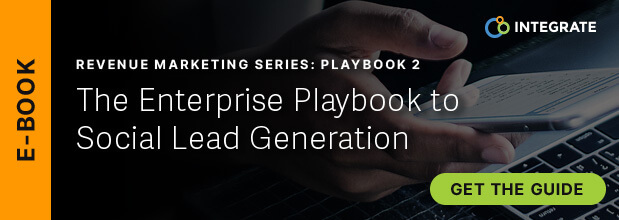How to Scale B2B Social Media Marketing in 2019
An astounding 94 percent of B2B marketers have a LinkedIn profile, and 89 percent of B2B marketers are harnessing Facebook for their marketing initiatives. As B2B marketers, we know the value of reaching our prospects where they consume media, however, leads collected on social aren’t always actionable.
Incomplete and unusable data garnered from Facebook and LinkedIn campaigns brings heartbreak countless marketing databases and results in sales’ mistrust in prospect data gathered from social platforms, and thus, inability to scale.
To help account-based marketers scale revenue generated from social media channels, we hosted a webinar with practitioners from Microsoft, Facebook, and LinkedIn titled, “Social for Scale: How B2B Marketers Will Use Facebook and LinkedIn in 2019.” After the webinar, we released our new eBook, “The Enterprise Playbook to Social Lead Generation.” Download it here.

During the webinar, Anika Kaulius from Microsoft, Brent Hicks from LinkedIn and Noah Choi from Facebook, contributed valuable advice for account-based marketers eager to maximize ROI on their social media investments. Here are some of the highlights.
How can B2B marketers take their social strategy from the 101 level to a 201 level?
Noah: Activate the first-party data. The reason this is so important is that Facebook has a wealth of information, but in terms of products that have a longer sales cycle, things like B2B software, enterprise software, you as the marketer are always going to know more about who’s the best fit for that in the targeting that will. So being able to match CRM list with their platform, build lookalikes, which is a really core tactic that a lot of these sort of 201, more sophisticated marketers use.
The second thing is using creative as a performance driver. I think one thing that differentiates Facebook and LinkedIn and other mobile platforms from more traditional forms of lead marketing is that you have this wealth of ways in which to be creative to engage your customer. Having a video strategy or an animation strategy we found as absolutely core to having sort of a 201 lead generation campaign. If you have those two things, it makes it easier for you to be always on. The real efficiency and the predictability, that comes when you can be running campaigns continuously and optimizing them in real-time.
Brent: I think where LinkedIn differentiates in terms of 101 to 201, in terms of content is really thinking about the value exchange with the audience and segmenting out your content to provide value with the audience, thinking the audience first and all the content and copy that you’re putting onto this site, so for example, we have the ability to segment by industry or job function very accurately.
Anika: As we evolve our social strategy, we tend to define nuanced opportunities for quality indicators that help determine whether or not the leads that we are acquiring through these social platforms are actually paying off with revenue outcomes downstream.
How can B2B marketers route social leads to their marketing databases?
Noah: Facebook offers a whole bunch of different ways to do this that kind of range from the small scale and more manual to the large scale and more automated. We have a form-fill product, Lead Ads. Any data that comes in through a lead ad you can just extract from the platform and it’s the SB file of text file. That’s, obviously not a super scalable thing, so for a company like Microsoft, that’s not really going to work out so well. The other thing we offer is a number of APIs, both to have marketers extract the data and scale and actually send us back some data for optimization, targeting measurement, things like that. There are a couple of companies that have built on our API. Integrate is now one of those companies that automatically extract that data and pipe it into a CRM.
How are professionals behaviors changing and how does that affect how B2B marketers engage with them on social platforms?
Brent: Something that we’ve seen a great deal of sort of happening in the market over the past couple of years is that because mobile is so ubiquitous and you manage everything through this device. You’re managing your professional life. That you’re kind of bringing through this device you’re kind of bringing these two parts of yourself together and what that’s done in B2B is it started to actually break down what we think of a contextual marketing channel for business marketing.
Public vs. work email
Brent: People’s personal life and their work life–there’s some blurred lines. But fundamentally, that mindset that a consumer might have leveraging their personal email address versus their work email address is, obviously, a different mindset. And so where we want to capitalize in the B2B space is understanding that personalization is important, and there are behavioral attributes and indicators that tell us whether or not a consumer might be in a personal mindset or a commercial mindset. But that we need to be able to identify that person on a one-to-one basis so we can have that personal communication with them even if it’s in the commercial environment.
Anika: We’re never going to walk away from the idea of the email and leveraging your corporate email to do your business. We want the customer, we want the member to have that world-class experience. But at the same time, we also have to do our job, and part of our job is, quite simply, it’s routing and sort of stacking the right organizations with the right prospects, with the right roles and titles, and sort of all those things within our system. So more to come on that one. But the quick and dirty answer is it seems like both social channels, LinkedIn and Facebook, are capable to collect that data today, and then using tools like Integrate or others to be able to append, and enrich, and validate before you push it through is seemingly the most meaningful way to keep that business email as unique identifier as we move through the process of lead collection.
How is Microsoft approaching social ABM?
Anika: One of the inherent challenges of leveraging ABM in a social environment is the idea that we need to be able to accurately identify those accounts. And so if you’re not able to accurately identify those accounts or in the instances where those accounts maybe don’t exist at scale in an ABM world where we’re looking to drive, obviously, revenue outcomes again, we have to balance that with efficiency. And so the more niche your audience gets, obviously, the more expensive it is to target them. And so when you start out with what might be a large list of accounts and then you look at okay, how do I do the match rates against these different social platforms? And then knowing that after that, I have a match rate, how do I ensure that the leads that are coming in are actually mapping back to those list of accounts that we have?
We hope this wrap-up gave you additional insights into the process of implementing strategic B2B social media practices to scale your efforts. Download “The Enterprise Playbook to Social Lead Generation” to learn more.









